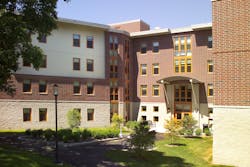Colorful, Cost-Effective Cladding Solution
Related To:
Dec. 1, 2015
2 min read
LOCATION:
Kingston, R.I.
DESIGN TEAM:
General Contractor: Gilbane Building Company
CHALLENGE:When the University of Rhode Island started the largest building project in its history, cost and aesthetics were important factors when choosing exterior cladding. Reinvestment of dollars saved by reduced energy costs is a practical, cost effective way to ensure a structure’s long-term efficacy.
INFLUENCE:Eddy, Garrahy and Wiley halls are the first new residence halls to open on the Kingston Campus since 1971. Giving them a fresh look was very important.
SOLUTION:The construction was completed in the fall of 2006; builders used 45,000 sq. ft. of Dryvit Outsulation MD on the expansion. Dryvit Outsulation Systems can be up to 84% more energy efficient than other common claddings, including brick, glass, concrete, wood and masonry. This energy efficiency translates into annual savings that average between 20% and 30% for every year the building is occupied.
Architect Rick Bouchard, S/L/A/M Collaborative, says “it was really a combination of aesthetics and economics—Dryvit Outsulation is much more cost efficient than traditional clay brick, and its light weight allowed us to save money on the structural elements of the buildings.”
In addition, there are aesthetic benefits. “One of the main factors that lead us to select Dryvit was the color options,” says Chris Browning, general contractor for Gilbane Building Company. “The architect created numerous electronic renderings using different color combinations and also requested mockups of the finishes that we reviewed on site.”
The Outsulation MD system also provides three lines of defense against water intrusion: the combination of reinforced base coat and finish; the grooved expanded polystyrene (EPS) with drainage track and vent assembly; and Backstop NT, an air and waterresistive barrier.
The dollars saved by using Dryvit products will compound over the typical 50-year life of the buildings and can be reinvested in technological upgrades, systematic maintenance, or in new projects.
nullKingston, R.I.
DESIGN TEAM:
General Contractor: Gilbane Building Company
About the Author
John Mesenbrink
Senior Editor
Sign up for our eNewsletters
Get the latest news and updates
